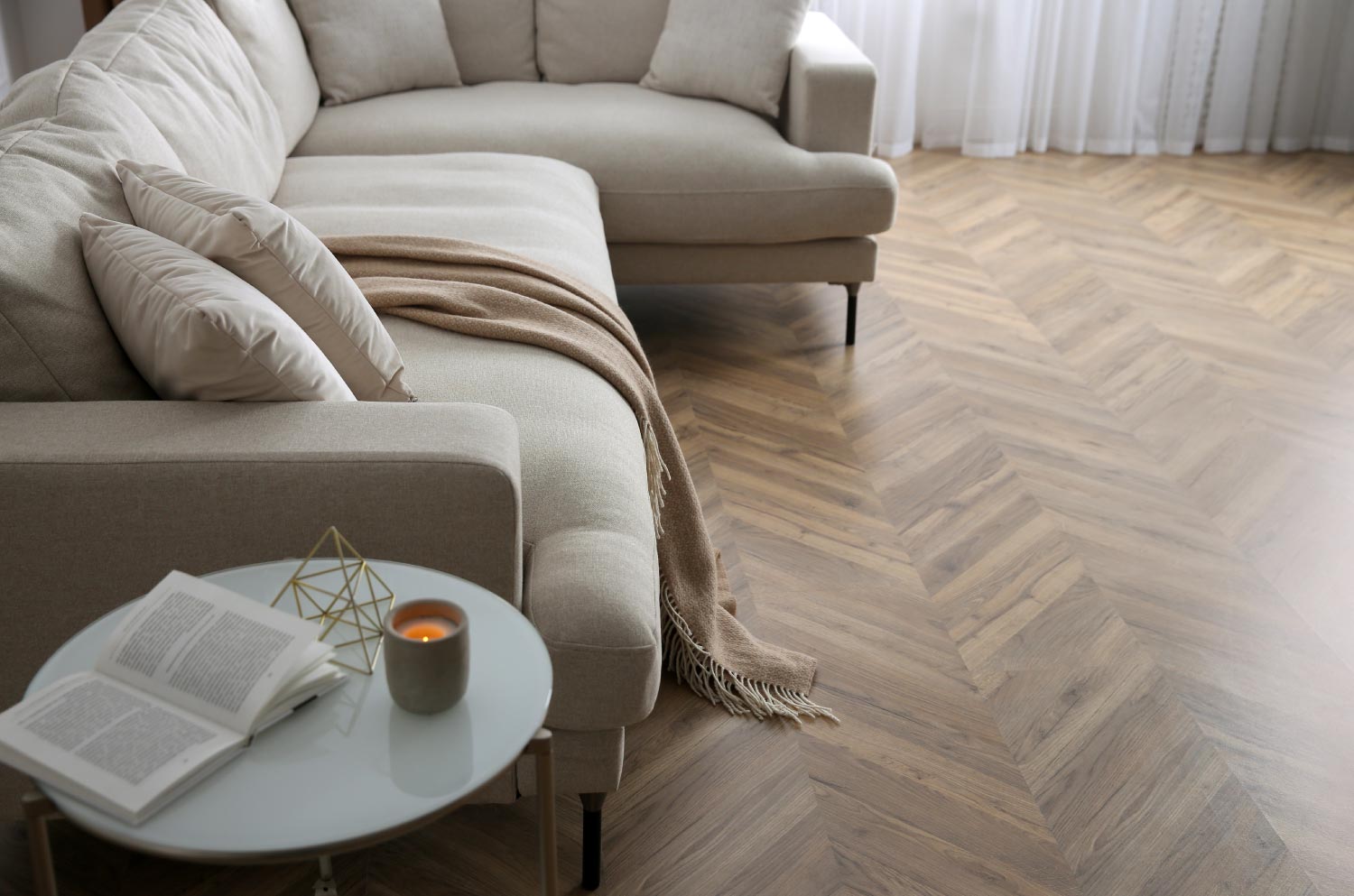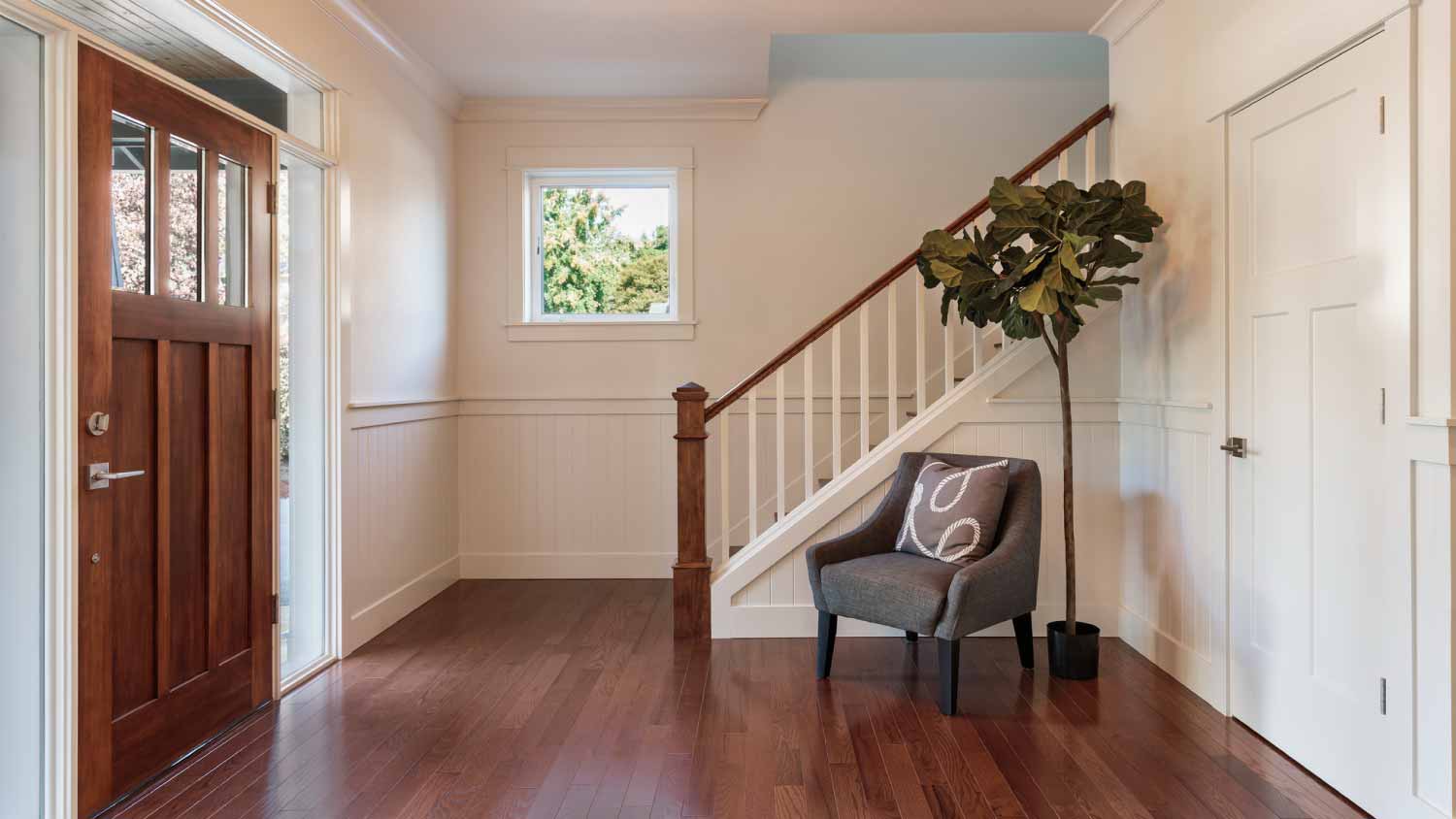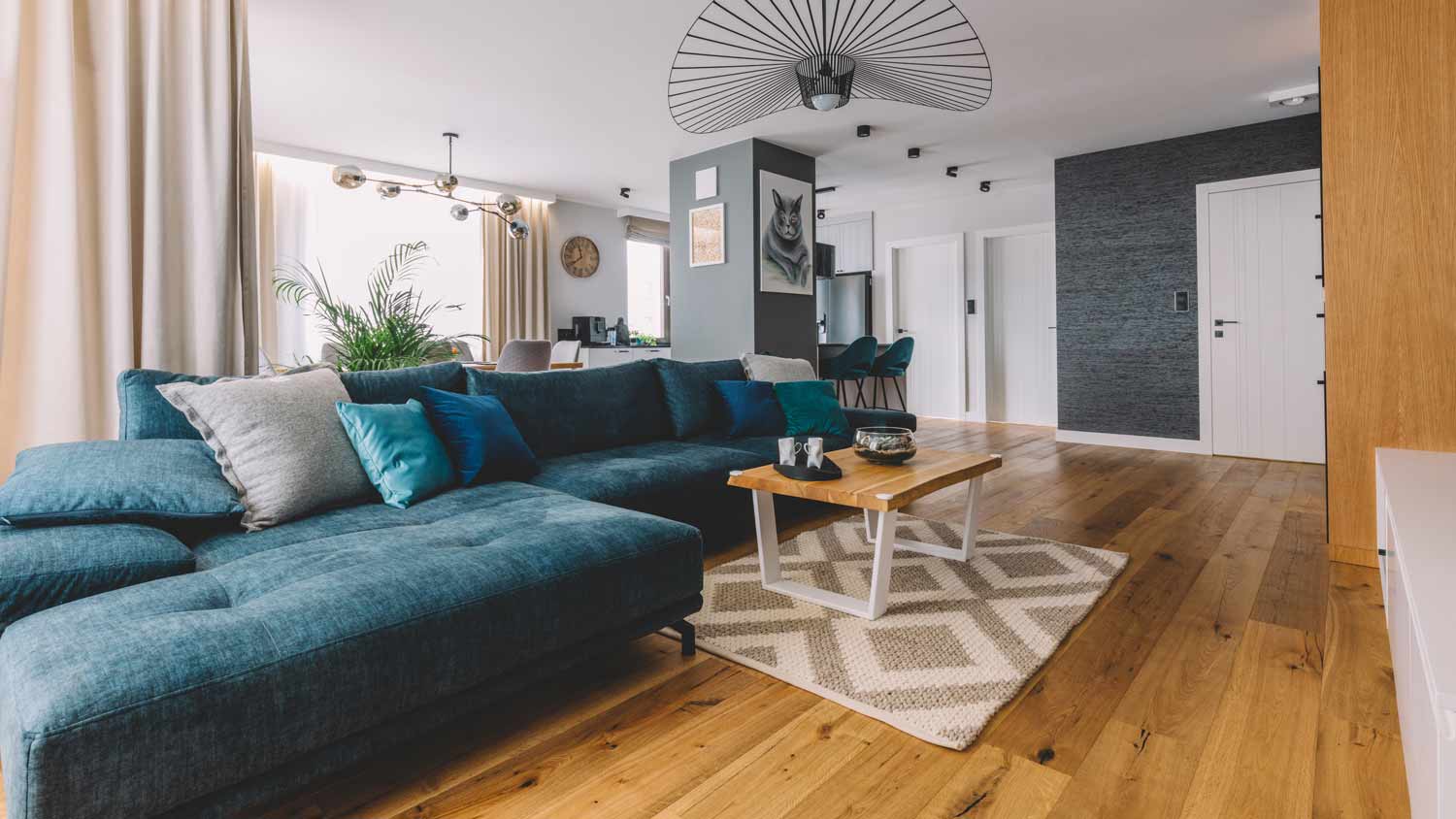How Much Does Vinyl Flooring Installation Cost? [2025 Data]
Installing new vinyl flooring costs $1,010 to $4,122, with an average of $2,566. A pro will determine the cost based on size, material, and subfloor condition.


If you’re in the market for new flooring, you have probably already learned that vinyl is one of the most popular flooring materials—and for good reasons. People love it for its range in price, versatility, and durability. Vinyl flooring installation costs range between $2 and $7 per square foot on average, but some options cost as low as $1 and as high as $14 per square foot.
However, estimating the cost of installing vinyl floors depends on various factors, including the type of material, the size of the space, and the installation cost in your area.
Vinyl Flooring Installation Cost Factors
When you're on the hunt for a tough yet budget-flexible flooring option that freshens up a room, vinyl often takes the cake. Vinyl's versatility means that you'll find quite a wide price range for materials and labor. It can also look as stylish as other pricier types of flooring without sacrificing your budget.
For example, manufacturers use vinyl to mimic wood, stone, and other popular materials. They also offer sheets and planks with an array of durability levels against water, scratches, and general wear.
Let's take a look at the major price factors so you can make the best choice in vinyl flooring for your home.
Quality of the Material
Each part of the vinyl sheet—from the backing through the core—contributes to its cost. In turn, the quality of the material in each layer contributes to its appearance, durability, and ease of installation.
You will find standard, yet budget-friendly, sheet vinyl flooring for just $1 to $2 per square foot. At the same time, you can also choose luxury vinyl planks and tiles that come with solid vinyl cores or specially treated top layers for longevity. These will cost you between $7 and $10 per square foot on average.
The coloring and design of the vinyl flooring will always play a role. Paper-printed vinyl costs just $1 to $5 per square foot, while inlaid vinyl—which comes from compressing color granules into the material—costs up to $12 per square foot.
Cost per Square Foot
It's no surprise that your per-foot cost for vinyl floor installation is, by far, the largest cost factor. In most cases, the larger the room, the higher the price. Some professionals will offer discounted per-foot rates for larger jobs. At an average of about $5 per square foot, you'll pay $1,000 for a 200-square-foot room.
| Square Footage | Average Costs |
|---|---|
| 100 | $500 |
| 150 | $750 |
| 250 | $1,250 |
| 300 | $1,500 |
| 500 | $2,500 |
Installation Method
There are several ways to secure vinyl panels and tiles to the subflooring, and each comes with different labor costs. Per-foot costs will depend on the type and quality of the material and how tricky it is to secure it to your floors.
Floating Floor
Floating installation takes less time to install and requires fewer materials. In this method, tiles or planks click and lock together and sit right on top of the existing floor without gluing or renovating the floor beneath.
Glue-Down
Planks, tiles, and some forms of vinyl sheets require glue to attach to the subflooring with this method. Budget extra money for both labor and materials—for example, the glue and tools to spread it.
Peel-and-Stick
While they may sound like the simplest solution, vinyl floors with existing adhesive fall between floating floors and glue-down planks in the cost range. Peel-and-stick will attach immediately to the subflooring, so any inconsistencies or unlevel areas must be addressed beforehand.
Coloring Method

There are lots of different options available to you for vinyl flooring, so you’ll be able to choose the exact color and designs you’re looking for. The flooring costs vary depending on whether the color and designs are printed or inlaid.
Printed Vinyl Flooring
Printed vinyl flooring costs around $1 to $6 per square foot. The color, pattern, or design is printed onto a paper layer. This layer sits on top of a thin vinyl layer, and manufacturers add clear vinyl or polyurethane layers on top.
This is how most vinyl composition tiles, vinyl sheets, and some planks are made.
Inlaid Vinyl Flooring
Inlaid vinyl flooring averages $5 to $12 per square foot. Unlike printed flooring, the design of the inlaid flooring extends all the way from the top to the bottom of the planks or tiles. It’s also more durable and can withstand scratches and moisture better than printed counterparts.
Luxury vinyl tiles and planks are usually inlaid. These often mimic expensive flooring materials like different types of wood or stone.
Labor Costs
If you choose to skip the DIY route, a professional vinyl floor installer will charge anywhere from $3 to $10 per square foot for labor alone. Planks with simpler installation options, such as floating floors, will cost less per foot than glue-on planks.
You may also receive a per-hour quote of around $36 an hour to install vinyl flooring. Keep in mind that uniquely shaped rooms or stairs will add to this price.
Cost of Vinyl Flooring by Type
When you head off to the flooring store or scroll through countless options online, one of the first decisions you'll make when deciding to install a vinyl floor is the type of sheet, plank, or tile. Let's look at the cost ranges of different vinyl flooring types.
| Type of Vinyl Flooring | Average Cost (Per Square Foot) |
|---|---|
| Vinyl Plank | $2–$7 |
| Luxury Vinyl Plank | $3–$10 |
| Vinyl Sheets | $1–$2 |
| Vinyl Composition Tile | $1–$4 |
| Luxury Vinyl Tile | $2–$10 |
Vinyl Plank Flooring
Standard vinyl plank flooring comes in a range of thicknesses but often runs thicker than other varieties if designed with the click-and-lock feature. Vinyl plank flooring installation costs about $2 to $7 per square foot, depending on added features like a water-resistant core and top layer to protect against scratches and stains that naturally happen in a busy home.
Luxury Vinyl Plank Flooring
Also known as LVP, this highly durable product will range anywhere from $3 to $10 per square foot and can be glued or floated over many types of subflooring. The plank's intricate design and top layer most closely resemble hardwood flooring, and it’s durable, even in high-traffic areas.
Before deciding to invest in this option, you might look at the luxury vinyl flooring pros and cons. For many people, it’s a great cost-effective alternative to hardwood flooring.
Vinyl Flooring Sheets
This budget-friendly vinyl flooring option costs between $1 and $2 per square foot and is one of the easiest to install. It comes in rolled sheets of 6 or 12 feet and can be cut to the shape of your room.
Vinyl Composition Tile Flooring
Costing between $1 and $4 per square foot, composition tile flooring comes with either wood and plastic or a stone polymer core for extra strength. The tiles come in peel-and-stick or glue-on varieties and mimic a wide range of materials.
Luxury Vinyl Tile
You'll pay anywhere from $2 to $10 per square foot for luxury vinyl tile (LVT) due to its wide range of available materials and finishes. The individual tiles come with wood or stone designs to look like the real thing without the high maintenance requirement. A urethane top often makes luxury vinyl tiles more resistant to wear and tear.
Additional Vinyl Flooring Costs to Consider
Major installations like these often come with additional costs to make the project run smoothly from start to finish.
| Additional Vinyl Floor Costs | Average Cost |
|---|---|
| Remove old flooring | $32 per hour or $1–$2 per square foot |
| Subfloor replacement or repair | $3–$10 for subfloor replacement or $400 for repairs |
| Underlay | $0.50 per square foot |
| Vapor barrier | $0.15–$0.40 per square foot |
| Move furniture | $25–$50 per hour for each mover |
Removing Old Flooring
You'll pay about $32 an hour or $1 to $2 per square foot to have a pro remove your old floors. Some companies will include this service, as well as hauling costs, in their flat fee.
Subfloor Repair or Replacement
Repairing and replacing subflooring may be a necessary step for successful installation and use down the line. You'll pay between $3 and $10 for the cost of subfloor replacement or an average of $400 for subflooring repair costs.
Underlay
Plywood underlayment can even the level of a floor, diminish sound, support stability, and even make your floor more comfortable to walk on. If recommended, you'll pay an extra $0.50 per square foot for the extra layer.
Vapor Barrier
Vapor barriers cost between $0.15 and $0.40 per square foot and come in handy when layering vinyl flooring over concrete. Concrete can absorb moisture, leading to buckling, warping, and installation issues.
Moving Furniture
You may need a hand moving the furniture from your room before replacing the floors as well. The cost of movers ranges from $25 to $50 an hour for each mover.
Stairs
Assume that your per-square-foot cost for labor will fall on the higher end of the labor cost range for stairs. Installing vinyl flooring on stairs costs more due to the intricate cuts and adhering necessary for the small areas.
Layout
Similar to the additional costs for stairs, a home with a complex layout will cost more than an open floor plan with easy-to-measure spaces. Smaller areas, such as walk-in closets, foyers, or L-shaped rooms, require more planning and trimming.
Warranties
While most floor installation specialists will guarantee their work under certain conditions, they may also offer upgrades for longer warranties or plans with wider coverage.
Cost to Install Vinyl Flooring Yourself

Installing vinyl flooring is a mid-level project for an experienced DIYer. While it's not quite as simple as snapping it all together like a tabletop jigsaw puzzle, vinyl floor installation rarely requires complex tools. You will also only pay for the cost of the flooring at an average of $2 per square foot, plus the cost of measuring and installation tools. You can purchase click-and-lock, peel-and-stick or glue-on flooring kits with specific instructions on how to trim and secure each plank or tile.
If you’re fairly new to installing flooring, you may want to learn how to install sheet vinyl flooring before working with planks or tiles.
When ordering flooring materials, first measure the square footage of the floor space. You may need to add an extra 10% for wastage during the installation process. A flooring pro can provide guidance for more challenging layouts or stairs.
DIY vs. Hiring a Pro
DIY floor installation is only best when you have sturdy subflooring without any additional underlayment needs or adjustments. Structural issues like water damage or old planks should always be addressed by a professional. Additionally, installing even simple flooring requires very intricate measuring, so if you're in doubt about the process, calling a local vinyl flooring contractor can save you from costly floor repairs or replacements in the future.
How to Save on Vinyl Flooring Installation
If you’d like to save on your new flooring costs, the easiest way is to look at the materials and choose something that’s more budget-friendly. The most affordable option is vinyl sheet flooring, which costs about $1 to $2 per square foot. Always speak to at least three flooring pros and request estimates from each so you can compare.
Also, if you’re up to doing some DIYing, you can do some of the prep work yourself to save on the installation costs. Depending on your existing flooring type, you may be able to take on the flooring removal job.
And instead of hiring professional movers, you can enlist some helpers around the house to help you move any big furniture pieces out of the way before the flooring installers show up.
Pros and Cons of Vinyl Flooring
For many homeowners, vinyl flooring is an irresistible choice because it offers the look of more expensive flooring at affordable prices. It is available in a wide range of styles that resemble the look of wood, stone, and even tile in exciting patterns. The material is also water-resistant and durable, making it a favorite for busy kitchens and bathrooms.
Of course, every good thing has a few downsides. Vinyl flooring lacks the warmth and natural feel of actual wood or stone, a turn-off for those looking for qualities only found in organic materials. Additionally, while vinyl is durable, it can be easily scratched or damaged by sharp or heavy objects. Lastly, vinyl is not eco-friendly, but some vinyl flooring manufacturers offer more environmentally-conscious options.
How Angi Gets Its Cost Data
Home is the most important place on earth, which is why Angi has helped more than 150 million homeowners transform their houses into homes they adore. To help homeowners with their next project, Angi provides readers with the most accurate cost data and upholds strict editorial standards. We’ve surveyed thousands of real Angi customers about their project costs to develop the pricing data you see, so you can make the best decisions for you and your home. We pair this data with research from reputable sources, including the U.S. Bureau of Labor Statistics, academic journals, market studies, and interviews with industry experts—all to ensure our prices reflect real-world projects.
Want to help us improve our cost data? Send us a recent project quote to costquotes@angi.com. Quotes and personal information will not be shared publicly.
Frequently Asked Questions
Comparing laminate and vinyl flooring is a common conundrum for homeowners, as both materials serve similar purposes as affordable and durable flooring options. However, since vinyl often comes with a waterproof core, it is more durable than laminate in water-prone areas. Laminate costs a bit less than vinyl at $1 to $5 per square foot compared to $3 to $7 per square foot.
Underlay is unnecessary for most vinyl flooring, which includes cushioned backing to provide comfort and stability. Adding an extra thin underlay can be beneficial if you have uneven subfloors. Always check the manufacturer’s recommendations for the best results with your specific vinyl type.
Vinyl floors last between 10 and 25 years on average when you care for them and protect them against water damage, though higher-quality vinyl can last longer.
If your vinyl flooring has heavy wear and tear or if it's peeling, it's a good time to do a reinstallation. Other signs your flooring is nearing the end of its life span include bubbling, heat-damaged planks or tiles, and discoloration.
The cost of installing carpet can range between $3 and $11 per square foot, so it falls just over the cost of installing vinyl flooring at an average of $3 to $7. High-quality carpeting can also range much higher, even up to $20 per square foot.

.jpg?impolicy=leadImage)














